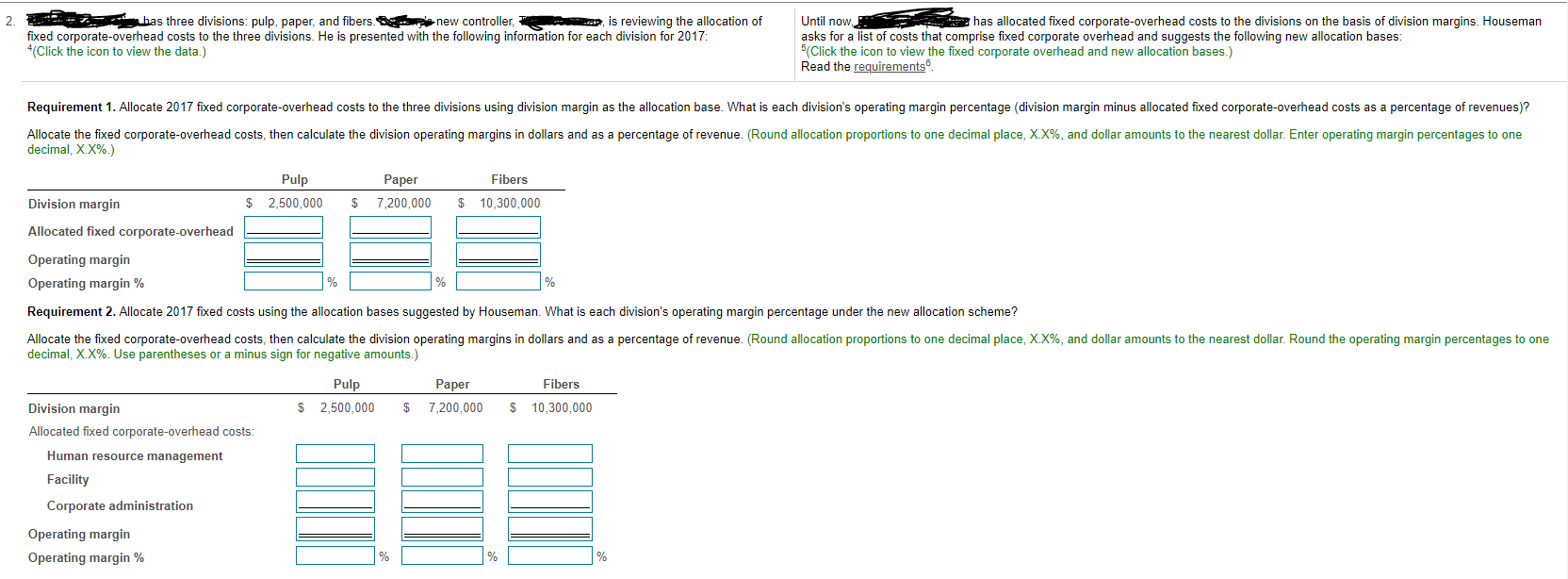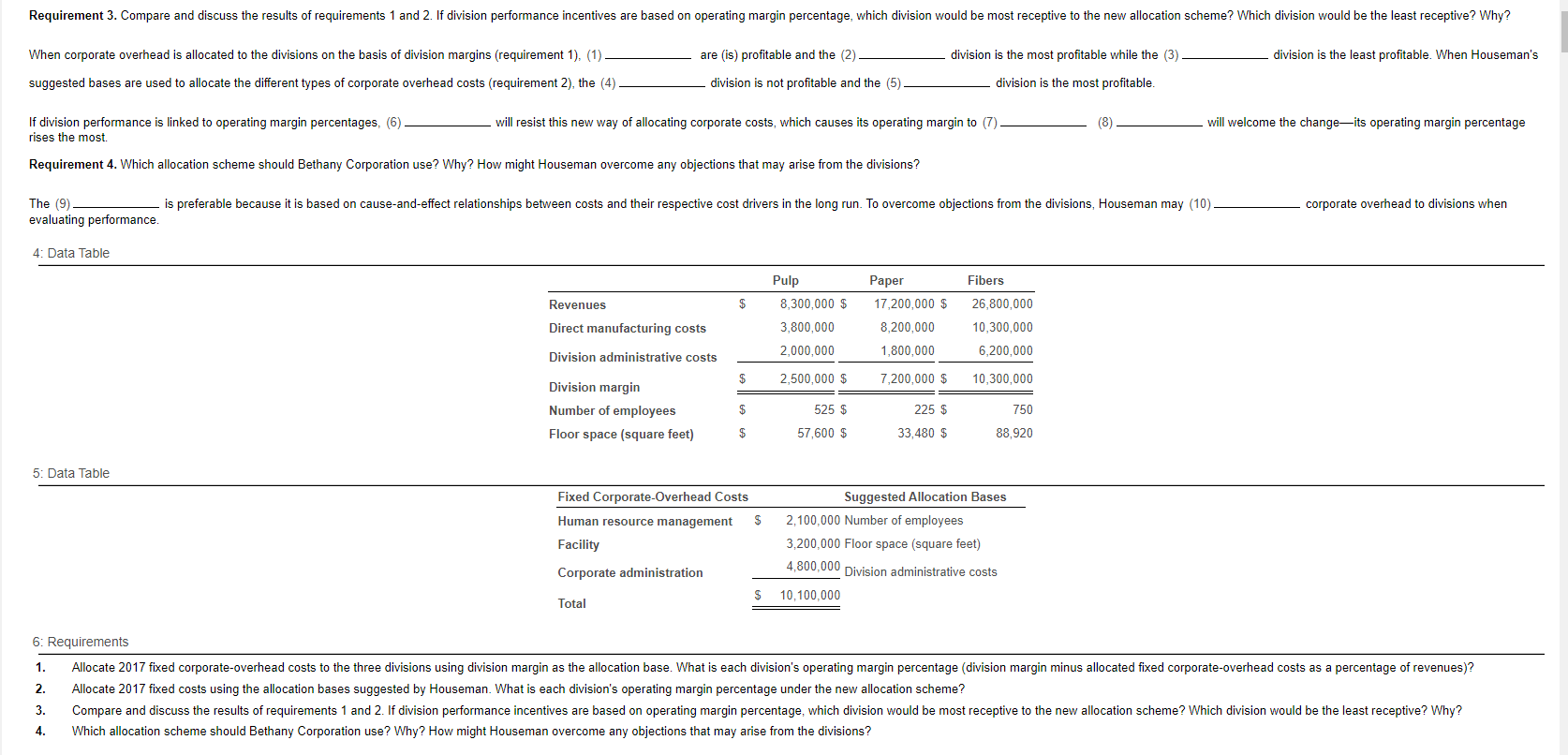Please work each section and please show work. If you cannot please do not answer the question. This is one question. 



- X Requirements 1. Allocate the support departments' costs to the operating departments using the direct method. 2. Rank the support departments based on the percentage of their services provided to other support departments. Use this ranking to allocate the support departments' costs to the operating departments based on the step-down method. 3. How could you have ranked the support departments differently? Print Done Data table Support Departments Human Information Resources Systems $ 40,000 $ Budgeted costs incurred before any interdepartment cost allocations Support work supplied by human resources department Budgeted number of employees Support work supplied by information systems department Budgeted processing time (in minutes) 350 Operating Departments Corporate Consumer Sales Sales 960,000 $495,000 48 32 1,750 1.400 220,000 $ 20 - X 2. has three divisions: pulp, paper, and fibers. new controller, is reviewing the allocation of fixed corporate-overhead costs to the three divisions. He is presented with the following information for each division for 2017: 4(Click the icon to view the data.) Until now. has allocated fixed corporate-overhead costs to the divisions on the basis of division margins. Houseman asks for a list of costs that comprise fixed corporate overhead and suggests the following new allocation bases: 5(Click the icon to view the fixed corporate overhead and new allocation bases.) Read the requirements. Requirement 1. Allocate 2017 fixed corporate-overhead costs to the three divisions using division margin as the allocation base. What is each division's operating margin percentage (division margin minus allocated fixed corporate-overhead costs as a percentage of revenues)? Allocate the fixed corporate-overhead costs, then calculate the division operating margins in dollars and as a percentage of revenue. (Round allocation proportions to one decimal place, X.X%, and dollar amounts to the nearest dollar. Enter operating margin percentages to one decimal, X.X%.) Pulp Paper Fibers Division margin $ 2,500,000 $ 7,200,000 $ 10,300,000 Allocated fixed corporate-overhead Operating margin Operating margin % % % Requirement 2. Allocate 2017 fixed costs using the allocation bases suggested by Houseman. What is each division's operating margin percentage under the new allocation scheme? Allocate the fixed corporate-overhead costs, then calculate the division operating margins in dollars and as a percentage of revenue. (Round allocation proportions to one decimal place, X.X%, and dollar amounts to the nearest dollar. Round the operating margin percentages to one decimal, X.X%. Use parentheses or a minus sign for negative amounts.) Paper Fibers Pulp Division margin $ 2,500,000 $ 7,200,000 $ 10,300,000 Allocated fixed corporate-overhead costs: Human resource management Facility Corporate administration % % Operating margin Operating margin % % Requirement 3. Compare and discuss the results of requirements 1 and 2. If division performance incentives are based on operating margin percentage, which division would be most receptive to the new allocation scheme? Which division would be the least receptive? Why? division is the least profitable. When Houseman's When corporate overhead is allocated to the divisions on the basis of division margins (requirement 1), (1) suggested bases are used to allocate the different types of corporate overhead costs (requirement 2), the (4). are (is) profitable and the (2) division is not profitable and the (5) division is the most profitable while the (3) division is the most profitable. will resist this new way of allocating corporate costs, which causes its operating margin to (7) (8) will welcome the change-its operating margin percentage If division performance is linked to operating margin percentages, (6) rises the most. Requirement 4. Which allocation scheme should Bethany Corporation use? Why? How might Houseman overcome any objections that may arise from the divisions? corporate overhead to divisions when The (9). is preferable because it is based on cause-and-effect relationships between costs and their respective cost drivers in the long run. To overcome objections from the divisions, Houseman may (10). evaluating performance. 4: Data Table Revenues Direct manufacturing costs Pulp Paper Fibers 8,300,000 $ 17,200,000 $ 26,800,000 3,800,000 8,200,000 10,300,000 2,000,000 1,800,000 6,200,000 2,500,000 $ 7,200,000 $ 10,300,000 Division administrative costs Division margin $ Number of employees $ 525 $ 57,600 $ 225 $ 33,480 $ 750 88,920 Floor space (square feet) $ 5: Data Table Fixed Corporate-Overhead Costs Human resource management $ Facility Suggested Allocation Bases 2,100,000 Number of employees 3,200,000 Floor space (square feet) 4,800,000 Division administrative costs Corporate administration $ 10,100,000 Total 6: Requirements 1. Allocate 2017 fixed corporate-overhead costs to the three divisions using division margin as the allocation base. What is each division's operating margin percentage (division margin minus allocated fixed corporate-overhead costs as a percentage of revenues)? Allocate 2017 fixed costs using the allocation bases suggested by Houseman. What is each division's operating margin percentage under the new allocation scheme? 2. 3. Compare and discuss the results of requirements 1 and 2. If division performance incentives are based on operating margin percentage, which division would be most receptive to the new allocation scheme? Which division would be the least receptive? Why? Which allocation scheme should Bethany Corporation use? Why? How might Houseman overcome any objections that may arise from the divisions? 4. $ 6: Requirements 1. Allocate 2017 fixed corporate-overhead costs to the three divisions using division margin as the allocation base. What is each division's operating margin percentage (division margin minus allocated fixed corporate-overhead costs as a percentage of revenues)? 2. Allocate 2017 fixed costs using the allocation bases suggested by Houseman. What is each division's operating margin percentage under the new allocation scheme? 3. Compare and discuss the results of requirements 1 and 2. If division performance incentives are based on operating margin percentage, which division would be most receptive to the new allocation scheme? Which division would be the least receptive? Why? 4. Which allocation scheme should Bethany Corporation use? Why? How might Houseman overcome any objections that may arise from the divisions? (1) O each division (4) O Fibers (5) O Fibers (6) O Fibers (2) O Fibers (3) O Fibers O Paper O Paper (7) O decrease to a loss (negative operating margin). O increase significantly. (8) O Fibers (9) O new approach O Paper O old approach O Paper O Paper O Paper O the Paper and Fibers divisions O the Pulp and Paper divisions O Pulp O Pulp O Pulp O Pulp O Pulp O Pulp O the Pulp and Fibers divisions (10) O initially choose not to allocate O just begin allocating










